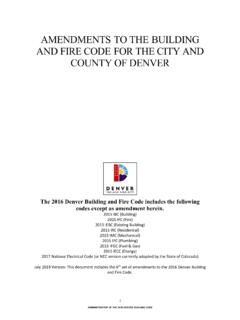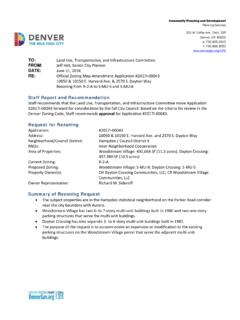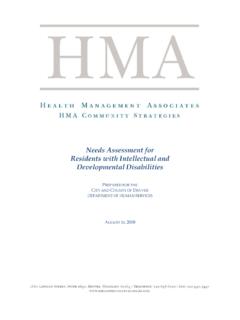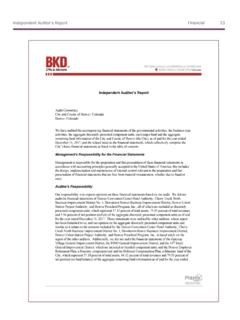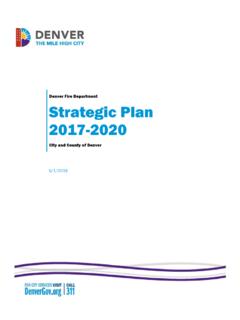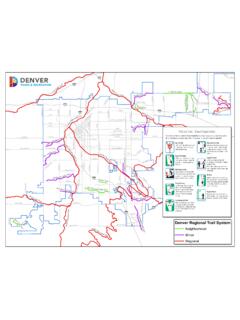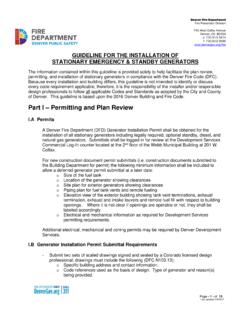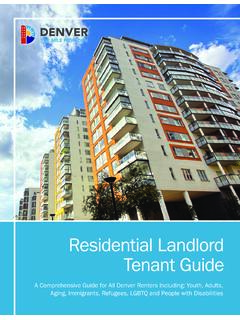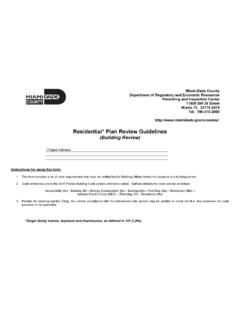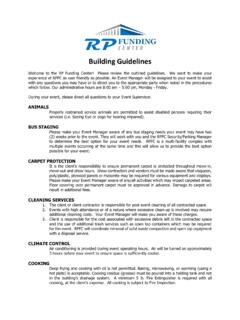Transcription of 4. GUIDELINES FOR NEW BUILDINGS & NON …
1 4. GUIDELINES for New BUILDINGS & Non-Contributing BUILDINGS | 7101-27-16 DENVER, COLORADO4. GUIDELINES FOR NEW BUILDINGS & NON-CONTRIBUTING BUILDINGSC onstruction of New BUILDINGS in Historic Districts and Alterations or Additions to Non-contributing Structures in Historic DistrictsThis chapter includes: Introduction .. Page 72 Design Review Process For New Construction .. Page 72 General Principles for New Construction .. Pa g e 74 Small-Scale Residential BUILDINGS .. Page 78 Site Design .. Page 78 building Design .. Page 79 Porches & Decks .. Page 82 Garages & Secondary Structures.
2 Page 83 Commercial, Mixed-use & Page 84 building Design .. Page 84 Parking Page 87 Plazas, Patios & Decks .. Page 88 Residential Context .. Page 89 New Construction & Environmental Sustainability .. Page 90 ILLUSTRATIONS USED IN THIS DOCUMENTThe design GUIDELINES include many photographs and diagrams to illustrate acceptable or unacceptable approaches. The illustrations are provided as examples and are not intended to indicate the only there appears to be a conflict between the text of the design GUIDELINES and a related illustration, the text shall TO ILLUSTRATION SYMBOLSA checkmark on an illustration indicates an approach that is generally asterisk on an illustration indicates an approach that may be acceptable in some contexts or X mark on an illustration indicates an approach that is generally | 4.
3 GUIDELINES for New BUILDINGS & Non-Contributing BuildingsDESIGN GUIDELINES FOR LANDMARK STRUCTURES & DISTRICTSINTRODUCTIONNew construction helps Denver s historic districts remain a vital part of the changing city. As change occurs, however, it should help reinforce the fundamental characteristics of the historic context and avoid negative impacts on the surrounding historic chapter provides GUIDELINES that promote new construction that is compatible with its context. It includes general GUIDELINES for new construction and specific guidance for small-scale residential (single-family houses, duplexes and town houses) BUILDINGS and commercial, mixed-use and multifamily BUILDINGS (including civic and warehouse BUILDINGS ).
4 Note that alterations to historic structures are covered in Chapter 2, and additions to historic structures are in Chapter 3. Site design, landscaping and lighting are addressed in Chapter REVIEW PROCESS FOR NEW CONSTRUCTIONL andmark Preservation reviews all plans for new construction in Denver s historic districts and on landmark properties. For more information on the appropriate design review process refer to pages 11-13 in Chapter 1 of this note that a two-step design review process applies to infill construction: Mass, Form and Context Review. This compares the overall scale and massing of the proposed structures to structures in the surrounding historic context.
5 Note that any proposed lot divisions and combinations are also reviewed during this step. Final Design Details Review. This con-firms changes made to scale and massing, as well as all proposed architectural details. RELATIONSHIP TO ZONINGThe Denver Zoning Code sets forth the fundamental requirements that apply to new construction throughout the city. New construction projects subject to design review with these GUIDELINES must also meet base standards for the applicable zoning district and building form, such as minimum setbacks and maximum height. In some cases, base zoning standards may not allow an element of a new construction project that is consistent with the surrounding historic context.
6 For example, in some historic districts, historic garage heights may be taller than garage heights permitted by current zoning. In such a case, a property owner may work with the Zoning Administrator and Board of Adjustment to seek a height or bulk plane adjustment, or other OF NON-CONTRIBUTING PROPERTIESThe GUIDELINES for new construction in this chapter also apply to projects involving an existing non-contributing structure in a historic district. The goal is to ensure that a non-contributing structure continues to fit within the overall GUIDELINES for new construction, meaning that it does not adversely affect the character-defining features of the overall historic district.
7 See Considering Historic Significance on page 16 and Appendix A for more information. The treatment of contributing properties is addressed in Chapter 2, starting on p a g e FEATURES OF A HISTORIC DISTRICTWhen planning new construction in a historic district, it is important to carefully review the district s character-defining features. See Appendix A: The Character-defining Features of Denver s Historic Districts for more GUIDELINES for New BUILDINGS & Non-Contributing BUILDINGS | 7301-27-16 DENVER, COLORADOD esigning in ContextDenver s historic districts are not frozen in time. They continue to evolve while maintaining their essential historic character.
8 A new building in a historic district should be compatible with the surrounding historic context, but also express its true age. A key objective is to retain the overall character of the district while accommodating creative, yet compatible, new BUILDINGS . It is important to understand how new construction will affect the ability to perceive the historic district s sense of time and place. Ideally, a new building will contribute to an understanding of the district, or at least incorporate a neutral design that has little impact. OVERALL COMPATIBILITY CONSIDERATIONSTo achieve compatibility, a new building should: Relate to the character-defining features of the historic district (see Appendix A for summaries), including setback and open space patterns, mass and form, entries and porches, materials and other features.
9 Relate to features in the surrounding historic context and on adjacent properties, including, setbacks, foundation, porch and window heights, the proportions of windows and architectural features, as well as roof forms. Express its true age, rather than directly imitating a historic style, or using faux historic treatments, to avoid confusing historic interpretation of the new building may use a variety of designs to achieve compatibility. These may include simplified interpretations of historic styles, or creative contemporary designs that incorporate compatible features. See Architectural Style for a New building on page 75 for more OF CONTEXTC ompatibility with context typically focuses on the character-defining features of the historic district, contributing structures in the surrounding historic context (usually other structures on the same block, including both sides of the street), and contributing structures on adjacent properties, as illustrated Context/ BlockAdjacent PropertiesHistoric District (See Appendix A)Adjacent properties generally include the immediate surroundings.
10 Properties adjacent to, facing, or overlooking a specific site, where the adjacent BUILDINGS are contributing and typify established historic patterns in the historic district. On a corner lot, the properties across the side street and diagonally across the intersection should also be DESIGN VARIABLES WITH THE SURROUNDING HISTORIC CONTEXTThe design GUIDELINES promote use of similar forms, materials and details to those used historically. However, this does not mean that total uniformity with the historic context is the objective. Rather, compatibility is achieved when a new building has a sufficient number of design variables which are similar in execution (but not necessarily identical) to typical design variables in the surrounding historic context.
